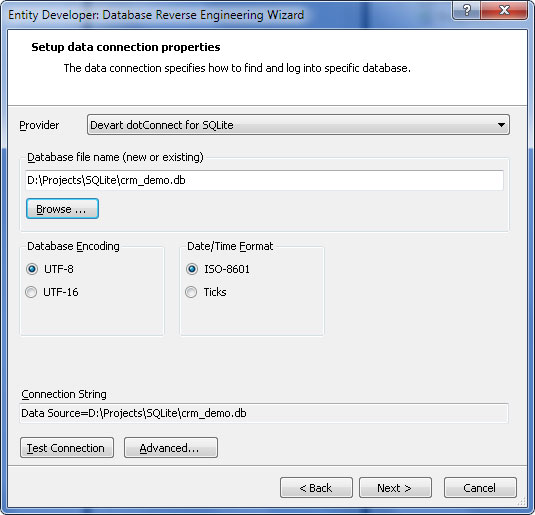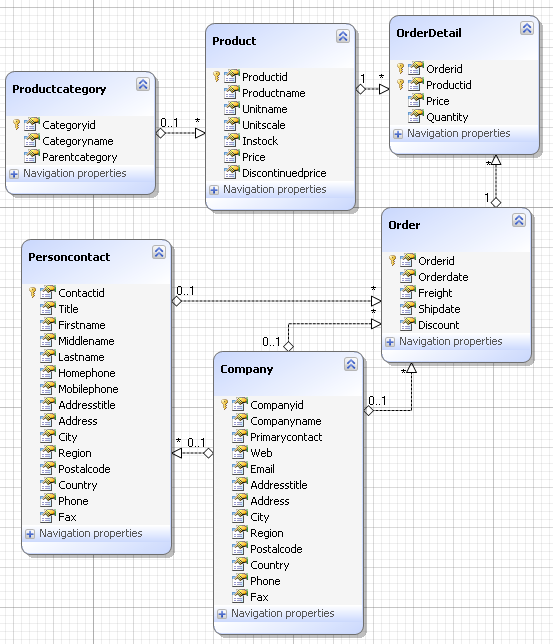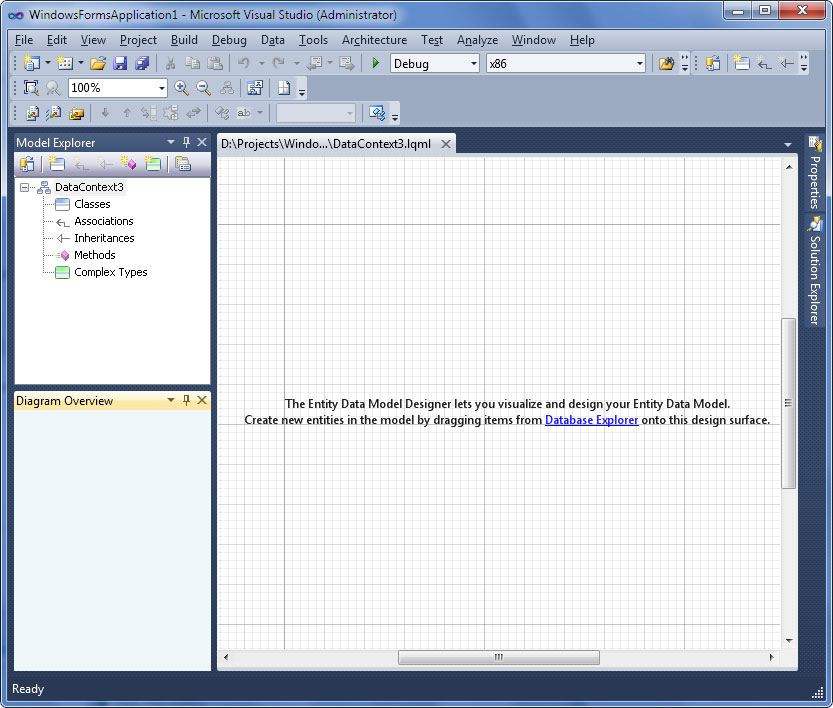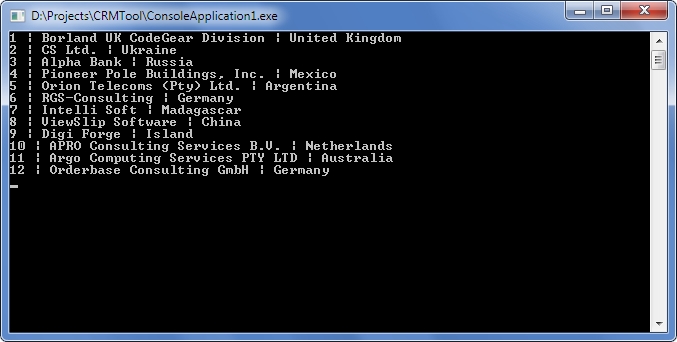This tutorial guides you through the process of creating a simple application powered by ADO.NET Entity Framework. In less than 5 minutes you will have a ready-to-use data access layer for your business objects.
Please note that this tutorial is not applicable for Entity Framework Core. It is intended for previous Entity Framework versions.
In this walkthrough:
- Introducing the ADO.NET Entity Framework
- Requirements
- Generating Model with Entity Developer
- Querying Data
- Inserting New Data
- Updating Data
- Deleting Data
- Additional Information
Introducing the ADO.NET Entity Framework
ADO.NET Entity Framework is an object-relational mapping (ORM) framework for the .NET Framework. It is designed to enable developers to create data access applications by programming against a conceptual application model instead of programming directly against a relational storage schema. The goal is to decrease the amount of code and maintenance required for data-oriented applications.
Requirements
In order to connect to SQLite database you need dotConnect for SQLite installed and IDE running. ADO.NET Entity Framework requires .NET Framework 3.5, Visual Studio 2015. Note that Entity Framework support is not available in Express Edition of dotConnect for SQLite.
In this tutorial it is assumed that you already have the database objects created. You have to create the database and execute a script from the following file if you have not done so yet: \Program Files\Devart\dotConnect\SQLite\Samples\crm_demo.sql
For Entity Framework 6, you will also need a NuGet Visual Studio extension installed since it is used for adding EntityFramework NuGet package. Alternatively you may create model for Entity Framework v1 or v4, which don't require NuGet, in this tutorial.
In this sample we will create a simple console application. It could be any other project type as well, but for simplicity's sake we'll use console project throughout the tutorial. Start Visual Studio and create a new console application.
Generating Model from Database
- In the Solution Explorer right-click on the project and choose Add | New Item.
- In the dialog choose Devart Entity Model, change its name to CrmDemo.edml, click Add. This launches Devart Entity Developer.
-
Create a new connection in the Database Explorer. To do it just click on the
Edit Connection Properties button on the Database Explorer toolbar.
When creating a
new connection choose Devart dotConnect for SQLite in the
Provider list and set a Database file name. Click
OK button to create the connection to the database. This step is illustrated in the screenshot below.

- Drag all database objects from the Database Explorer to the diagram. These
are all objects from the crm_demo script, including auxiliary tables.

- Press Save Project button. The model will be generated and saved in your project ( *.edml and related with it files).

The model you've just generated is ready to use. You can inspect it visually in Entity Developer with diagram and toolwindows, edit various aspects of classes and relationships, add new model elements. Remember that you have save the project to make the changes in Entity Developer reflected in Visual Studio.
Entity Developer generates classes for all selected tables that represent entities. It also creates a descendant of System.Data.Entity.DbContext class, which controls the connection to the database, and the whole data flow. This class includes properties and methods named after your database objects. You will use these members to retrieve and modify data in the context. The code is contained in an autogenerated file CrmDemo.Designer.cs (CrmDemo.Designer.vb).
Querying Data
All Entity Framework operations are executed through a DbContext descendant or through a ObjectContext descendant, which is named CrmDemoEntities in this tutorial. To retrieve data you have to first create an instance of the context, then prepare a query with LINQ to Entities or EntitySQL or their mix, and then access the object returned by the query, which may be a collection of objects or a single object.
Let's read all the data from the table Company, sort it by CompanyID, and output some columns. Add the following block of code to the method Main:
As simple as that. You prepare a query and then iterate through it as you would do with a usual collection of objects. The database interaction is performed by Entity Framework in the background. Now let's see who is who in this code sample.
- CrmDemoEntities is the name of the class that knows all about your model and does everything to handle it. You named it in the step 6. All Entity Framework operations are performed within this class's properties and methods. It is recommended that you keep a single instance of the class throughout your application because it consumes lots of resources.
- query, it - these are arbitrary variable names in the LINQ to Entities statement. The former is used as the collection of data objects, the latter is not used outside the statement.
- context.Company refers to a public property of CrmDemoEntities class. This property represents the collection of all companies in the context.
- Company (in the foreach statement) is the name of an autogenerated class. This class maps to the Company table in the database and is named after it.
Here is the project's output in the console:

Note that the LINQ to Entities query code just describes the query. It does not execute it. This approach is known as deferred execution.
Now let's query data from two tables united with a foreign key. Replace the old code with this:
This sample is much like the previous one, with exception that it adds the Include method that instructs the query to retrieve data from one more table.
Inserting New Data
What earlier was adding rows to tables, now is just adding new objects to context collections. When you are ready to send the changes to the database, call the SaveChanges() method of the context. Before doing this, you must first set all properties that do not support null (Nothing) values. The SaveChanges() method generates and executes commands that perform the equivalent INSERT, UPDATE, or DELETE statements against the data source.
Let's add a new product and a new category to the database. Replace the old code with this:
The methods AddToProductCategories, AddToProducts, and others are automatically generated in the context. Such methods exist for every class in your model.
Note that after you have added the new product and category by submitting the changes, you cannot execute this solution again as is. To execute the solution again, change the names and IDs of the objects to be added.
Updating Data
Entity instances are modified as usual. The only thing to remember is that you have to invoke the SaveChanges() method to send the data to the database.
Append the following block to the existing code and launch the project:
Deleting Data
To extract an instance from a context use the DeleteObject method of the context. The object is removed from the collection of its type, but not destroyed. To delete the object's data from the database invoke the SaveChanges() method.
You can do this with a block of code like the following:
Additional Information
Now that you can perform the basic data manipulation with Entity Framework, you can move on to some advanced topics. Here are some useful links to MSDN:
For hands-on experience download the separate Entity Framework Query Samples package or use samples shipped with dotConnect for SQLite. You can access the samples from the Start menu.
To understand deeper the works of Entity Framework engine you can watch the generated SQL statements in DBMonitor.
See Also
Entity Framework section | Entity Framework Support Overview